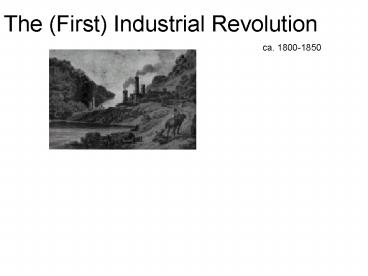The First Industrial Revolution - PowerPoint PPT Presentation
1 / 23
Title:
The First Industrial Revolution
Description:
This was made possible by earlier advances in metal working made possible by the ... Romanticism. Nationalism. Liberalism. Socialism. Conservatism ... Romanticism ... – PowerPoint PPT presentation
Number of Views:185
Avg rating:3.0/5.0
Title: The First Industrial Revolution
1
The (First) Industrial Revolution
ca. 1800-1850
2
The (First) Industrial Revolution
ca. 1800-1850
(cf. Neolithic Revolution) Use of mechanized
power Provided by coal/steam, etc. All-metal tools
3
Causes for Industrial Revolution (in Britain)
- -gtEnd of feudalism in Britain
- -gtEnclosure Movement
- -gtAgricultural Revolution
- -gtSurplus Labor
- -gtCottage Industries
- -gt Colonial Expansion
- -gt Commercial Revolution
- -gtTechnological Innovation
- -gtEspecially the Steam Engine
4
The invention of the steam engine was crucial.
5
This was made possible by earlier advances in
metal working made possible by the use of coke a
solid fuel made by heating coal in the absence of
air so that the volatile components are driven
off. ? carbon residue left after the incomplete
combustion or distillation of petrol or other
fuels. (OED)
6
and advances in mechanized production like the
spinning jenny
and cotton feels better than wool . . . . . .
good thing Britain had somewhere to get cotton.
7
Industrial techniques were shared
through study tours Lunar Society The
Society for the Encouragement of Arts,
Manufacture and Science And Others
8
The need to transport coal will lead to another
development--the train--which be deployed in
further industrialization and what is sometimes
called The Second Industrial Revolution.
9
But there were down sides . . .
10
(No Transcript)
11
And Child Labor . . .
- Until 1833, no restrictions on child labor
- 9-13 yrs. old work only nine hours/day
- 13-18 yrs. old work only 12 hours/day
- Until 1842 children worked underground in mines.
One nine-year-old, Margaret Comely, worked
7a.m.-6p.m., one muffin to eat w/out a break, and
flogged
12
And industrialization seems to overcome the
Malthusian point of crisis Industrialization
brings rapid population increases. And rapid
urbanization.
13
This urbanization, though affecting a small
percentage of European populations, was quite
visible. Their plight led to a number of
responses. One kind of response was from
religious groups aimed at educating and reforming
the poor.
14
Another response was aimed at domesticating
women
15
And the abolition of the slave trade (1807) and
slavery in the British Empire (1833).
William Wilberforce
16
The Social Problems and Tensions led to some of
our most famous -isms . . . Conservatism Romantici
sm Nationalism Liberalism Socialism
17
Conservatism
Emphasized the need to preserve the existing
order of monarchs, aristocrats, and the
established church.
Edmund Burke (1729-1797) had argued against the
French Revolution he believed notions of
equality undermined the social order.
Hannah More (1745-1833) argued that the solace
of religious faith was a rampart against
rebellion.
18
Romanticism
Was a rebellion against rationalism it was
primarily an artistic movement that emphasized
the importance of emotion.
Wolfgang von Goethe (1749-1832) Feeling is
everything
Often included in this group are Beethoven,
(George) Eliot, Worsdworth, Coleridge, and even
John Wesley.
19
Nationalism
The belief that people derive their identity from
their nation and owe it their primary loyalty.
For most people this would mean a shift from a
sense of regional identity.
Giuseppe Mazzini (1805-1872) believed nationalism
was a faith and mission ordained by God.
20
Liberalism
This is the most clear descendent of the
Enlightenment, especially in its reaction to
absolutism and insistence on individual rights.
This movement includes people like John Stuart
Mill and Jeremy Bentham. Bentham argued that the
purpose of government was to provide the greatest
happiness for the greatest number. (This is also
known as Utilitarianism.)
21
Socialism
Emphasize common ownership of property as a way
to human happiness.
This took a number of forms, but the most famous
was communism as advocated by Karl Marx.
22
Then, in 1845-46 a continent-wide depression
hit crop failures, potato blight (1 million
Irish starved to death between 1844 and
1851.) This led to the 1848 Revolutions
23
Industrialization Rise of West
Contingency Accident Conjuncture































